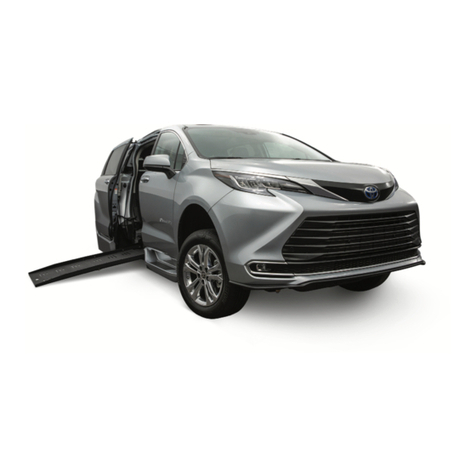
Fitting and using combined retractable tie-down and
occupant restraint
Fit and use
Rail oor - Quattro with retractable occupant restraints - Wheelchair tie-down
1. The rail will have been installed in the vehicle in accordance with our own and
the vehicle converter’s instruction. Position the wheelchair within the vehicle as
required.
2. Attach the front wheelchair tie-down (not supplied as part of this product) in
accordance with its own instruction.
3. Place the combined rear retractable restraint into the rail behind the wheelchair. It
is acceptable to use the restraint either for left hand or right hand use. The double
inertia reel (Fig 4) should be tted to the rail adjacent to the 3rd point anchorage.
When possible, the rear retractable tie-down should be positioned with the
karabiner or hook gates facing outboard from the wheelchair (Fig 1).
If using tongue & buckle, the buckle may be positioned facing inboard or outboard
(Fig 2).
4. Attach each tie-down into the oor rail by aligning the ATF (aluminium track tting)
feet with the cut-out sections of the rail, (Fig 3). Note: the yellow plungers must face
toward the rear of the vehicle. Press down on the ribbed part of the ATF, (Fig 3A), and
push rmly down towards the wheelchair until the yellow plunger drops and locks
into the rail. IMPORTANT: Ensure that the plungers and fully engaged on both
sides.
5. Press the yellow Quattro release button(s), (Fig 4A) to extend the webbing and
attach the karabiner, hook or tongue and buckle arrangement(s) around the
wheelchair main frame. Some wheelchairs will indicate this rear frame tie-down
position, (Fig 5).
6. Press each Quattro release button once again to take up the slack in the webbing
and create an angle of around 30 to 45° and within the rear view zone (Fig 6).
7. Final tensioning is achieved by turning each tensioning handle (Fig 4B), until the
webbing is equally taut on each side.
8. The occupant restraint must now be tted.
Removing the wheelchair
tie-down
First remove the occupant
restraint
1. Release the tension in the
rears by pressing the yellow
button (Fig 4A) and extend
the webbing to allow the
tongue & buckles, hooks or
karabiners to be removed
from the wheelchair frame.
If the webbing is particularly
tight, it may be necessary to
slightly ’tension’ with the hand
wheel (Fig 4B), whilst pressing
the yellow button, in order to
remove the webbing lock on
the Quattro.
2. Lift the yellow plunger fully,
slide back away from the
wheelchair to align the ATF feet
with the rail cut outs, lift away
from the rail.
3. Repeat operation with opposite
tie-down and store securely.
10 Combined retractable tie-down and occupant restraints

































